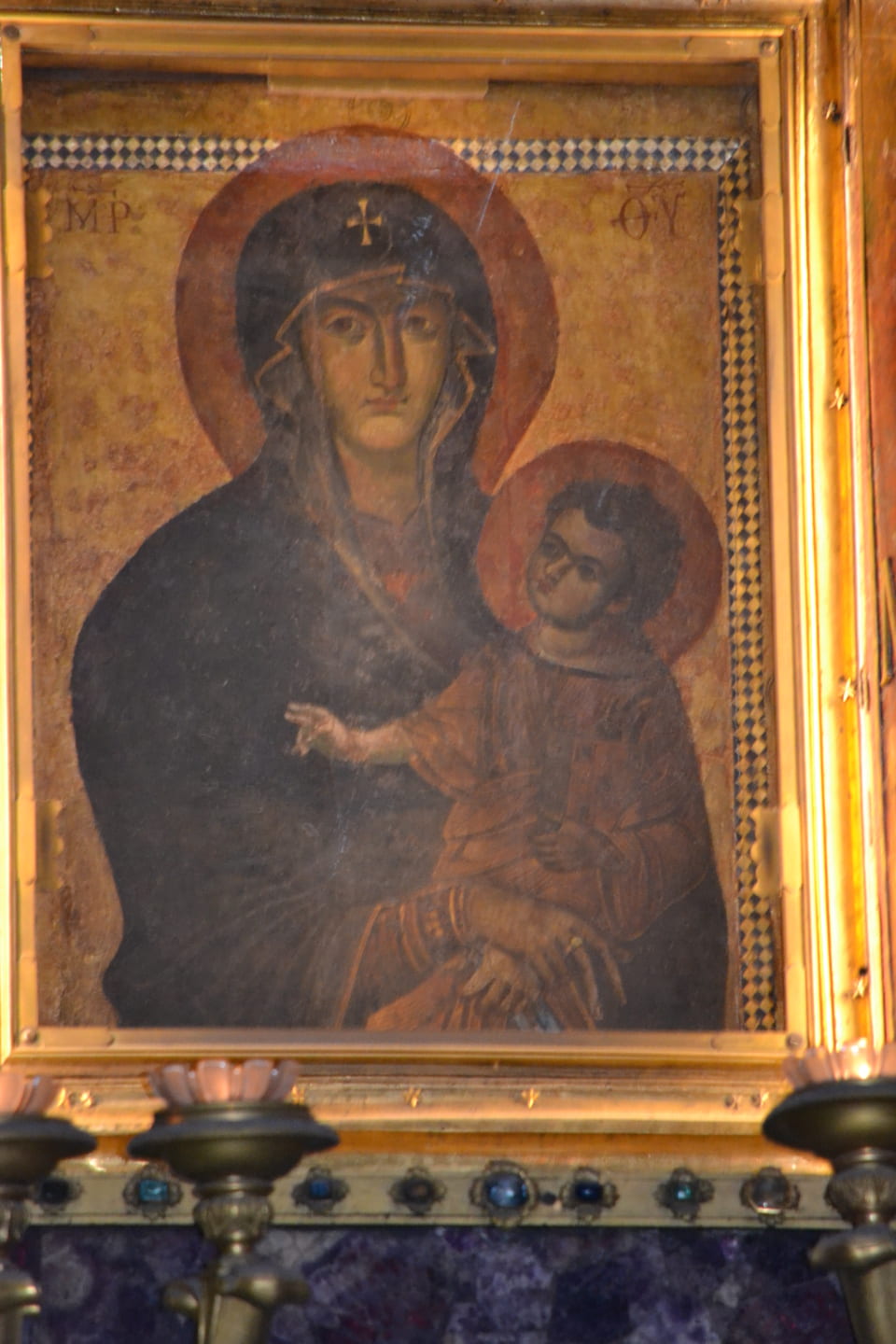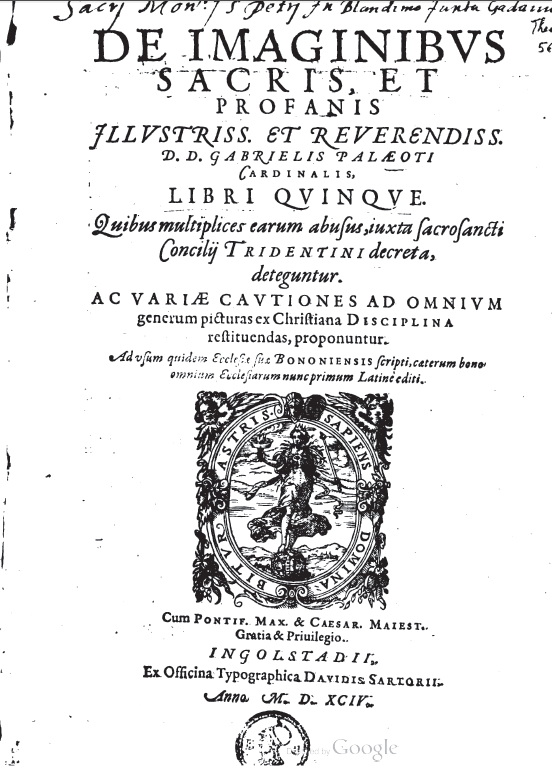by Madeline McMahon

The Salus Populi Romani in Santa Maria Maggiore, Rome.
In the fifteenth century, a rash of treatises were written by Italian clerics ascribing local icons of the Madonna and Child to St. Luke. Manuscript treatises such as that by the Roman canon Giovanni Baptista not only lent a prestigious provenance to icons like the Salus Populi Romani (claiming that it had been the icon Gregory the Great used in 590 to protect the city from plague) but also reinvigorated those icons’ cults (Nagel and Wood, Anachronic Renaissance, 109). The legend that the evangelist Luke had left behind visual as well as written testimony (that is, as a painter as well as a gospel writer) can probably be dated to the iconoclastic debates of the eighth century. Because Luke had made a portrait of the Virgin, this meant that all paintings of the Madonna and Child had “an apostolic pedigree” (Maniura, 90). But it also meant that some paintings, at least, offered an authentic likeness of the Mother of God. Whereas the bodies of saints were often physically accessible, it was believed that the Virgin had been assumed to heaven. A Lucan icon of the Madonna was a relic of the evangelist as well as a point of contact with Mary herself. As Alexander Nagel and Christopher Wood have argued, in the medieval period there was a double awareness that a Lucan icon could be “at once substituting for its immediate predecessor in the replication chain and also retaining an attribution to St. Luke” (72). This changed in the middle of the fifteenth century, when venerated images became more like relics—nonsubstitutable and historic—and more icons were given venerable histories.
In 1563, in the final days of the Council of Trent, a decree on the veneration of sacred images and relics was hastily put together that upheld “due honour and reverence” towards images of Christ and the saints “because the honour showed to them is referred to the original which they represent: thus, through the images which we kiss and before which we uncover our heads and go down on our knees, we give adoration to Christ and veneration to the saints, whose likenesses they bear” (emphasis mine, Decrees of the Ecumenical Councils, II.775). Bishops were entrusted with instructing and overseeing the appropriate veneration of images—and with interpreting the finer points of the decree, such as what was meant by the saints’ “likenesses” (similitudines). What did bishops after Trent make of sacred images purportedly taken from life, like the Lucan icons?
In his Discourse on Sacred and Profane Images (1582), Gabriele Paleotti, bishop of Bologna, included in his definition of sacred images both any paintings that depicted sacred subject matter and miraculous images like the volto santo, the cloth in Rome upon which Christ’s face was imprinted en route to his crucifixion (trans. McCuaig, 99 – 100). But aside from pointing specifically to the volto santo in St. Peter’s, he did not identify any biblical or apostolic works of art. The tradition that St. Luke had painted the Virgin was important to him, but primarily as textual proof that Christians’ use of images had ancient precedent. Like Nicephorus, the ninth-century patriarch of Constantinople he cited for his references to the Lucan icons, Paleotti felt the need to “prove the use of sacred images” against those who might contest it. While Protestant iconoclasts were not a problem in the diocese of Bologna, they seem to have been on the bishop’s mind.
But Luke’s painting of the Virgin had another important role in Paleotti’s demonstration that, over the centuries, “men of piety have striven to have the most lifelike images of [the saints] they possibly could in order to spur themselves more effectively with such images to imitate the road leading to heaven that those saints, while alive, had shown them” (212). Paleotti’s insistence that saints be portrayed “with the effigy they had in life, if that is known, or in a verisimilar fashion, or at any rate as typically good and intelligent persons who look the way they are likely to have looked” reveals his pastoral concern that images lead people to live the saintly lives they see depicted. He worried that a wicked face might make someone laugh or that a luxuriously dressed, well-fed saint would mislead viewers.
In 1624, Federico Borromeo, a mentee of Paleotti and cardinal-archbishop of Milan (like his more famous cousin before him), wrote his own work On Sacred Painting. Borromeo, too, did not point out specific Lucan icons. He mentioned the acheiropoieton image of Christ on the Holy Shroud of Turin, but brushed aside debate on its composition: “this is not the place to investigate how or by what technique it was made. There is at least no doubt at all that the image was made from life and with the greatest care” (trans. Rothwell, 71). Like Paleotti, Borromeo is interested in early Christian images made from life, but did not turn to icons to learn about them. Instead, as Paleotti did, Borromeo turned to texts, citing Nicephorus on the images painted by Luke and then quoting, in full, Nicephorus’s description of these images. Christ was blond with black eyebrows, just like his mother (73 – 5). Borromeo’s quotation was meant for painters: “I hope that painters who are making portraits of Christ and the Mother of God remember this one thing, which all early Christians believed and which the Church Fathers have handed down: that the face of the Savior was notable for its striking similarity to that of his Mother.” The description itself was important “to help painters render more life-like portrayals,” but so was the verisimilitude that a son should look like his mother (93).
When Borromeo did turn to early images, he looked to the recently reopened Christian catacombs and early medieval church paintings. Charlemagne’s visage could be recovered from the church of Santa Susanna in Rome, and could be verified by its similitude to images on seals, in an old codex of the Bible, and the description of Charlemagne’s biographer, Einhard (113 – 15). Unlike the relic-icons in the fifteenth century that were preserved as they were, Borromeo felt that these remaining ancient portraits were fleeting. He collected copies of them, imitating Varro’s collection of the portraits of famous men by preserving what was sometimes destroyed in his own lifetime (103, 113). He lamented, too, the opportunities to capture contemporary saints’ images, noting that “an almost unlimited amount of money was spent on images” of his recently canonized cousin Carlo “after his death, whereas virtually no one bothered to paint [his] face while he was alive” (107).
At the turn of the seventeenth century, there were new possibilities to learn about early Christian art—below ground in the catacombs and in new scholarship. Paleotti and Borromeo were both highly attuned to what might be accurate and appropriate in a religious painting. While they took note of some of the more famous medieval images of Christ, they tended to be silent about the icons of the Madonna and Child that had been so important in the fifteenth century. But instead of projecting either newly discovered or long-venerated images to the status of irreplaceable relics, they sought likenesses that could become the basis for new holy portraits. What mattered was the visage of St. Carlo Borromeo, or the sacred symbols that early Christians used to symbolize human figures or beliefs in the catacombs—an “ancient practice” that “we should uphold…and use more often” (Federico Borromeo, 99). The remains of early Christian art were important as material evidence, but also as information that directed living artists’ work.



Leave a Reply